Implantology
 Dental Implant
Dental Implant Dental Implant
Dental Implant
Dental implant is the latest innovation in replacing the missing teeth with the help of titanium screws or cylinder embedded (implant) into the jaw bone. Titanium in its commercially pure from is the most tissue friendly (biologically compatible) metal know to men. It integrates with the bone harmoniously. A portion of the titanium screw projects out of the gums after the implant has been placed into the jaw bone. This portion is used as an abutment onto which a porcelain crown is cemented or screwed. Two or more implants can be used to bridge a long edentulous area. A full denture can also be fixed by using multiple implants.
 Dental Implant
Dental Implant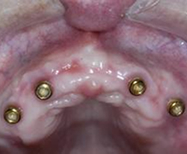 Dental Implant
Dental Implant
Advantages of dental implants:
- Implant gives a natural feeling like your own teeth and improves comfort.
- It is a fixed fixture and hence there is no need for removal from the mouth.
- Healthy tooth substance is preserved as no preparation of the adjacent teeth have to be done as in FPD.
- Usually after extraction of teeth the bone in that area resorbs causing a bony deformity and your face appears older. This resorbtion is prevented when implants are used.
- Aesthetic appearance, speech and facial expressions can be restored as the implant is fixed to the bone.
Contraindications for dental implant:
Relative:
- Smoking / tobacco abuse
- Alcohol abuse
- Diabetes (contolled)
- Low dose irradiation patients
Absolute :
- High dose irradiation patients
- Uncontrolled Diabetes
- Psychiatric problems
- Blood dyscrasias- Leukemia, Hemophilia, Thrombocytopenia.
Clinical procedures
The positioning of the implant in the jaw bone is a minor surgical procedure which can be done under local anesthesia in a dental clinic. A small incision is placed over the gums in the edentulous area and the titanium implant is placed into the bone and the soft tissues are sutured. It takes about 3 to 6 months for the implant to osseointegrate into the bone. After complete osseointegration of the implant to the bone a porcelain crown or bridge is placed over the abutments. An over denture may be given for this interim period as a temporary prosthesis.
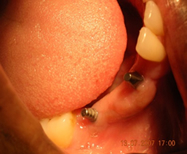 Implants placed
Implants placed
in the jaw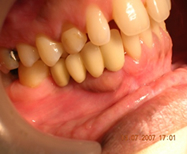 Fixed partial denture
Fixed partial denture
fixed on to the implants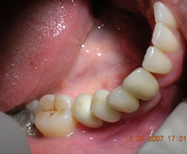 Fixed partial denture
Fixed partial denture
fixed on to the implants
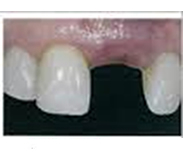 Pre operative picture of a missing
Pre operative picture of a missing
anterior tooth.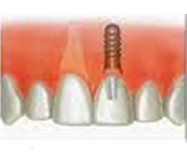 Post operative picture after
Post operative picture after
placing the implant Post operative picture after
Post operative picture after
placing the implant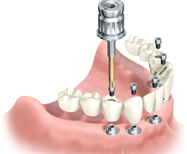
Care of the implant:
For long term success and uncomplicated extended lifespan of the implant, proper oral hygiene is very essential. Bacterial plaque is a threat to the implant as it is to natural tooth. Proper brushing with regular or special-toothbrush is a must after implant fixation. Extra care and time should be given for maintenance of the cleanliness (hygiene) of the mouth. Any lack of care of the implant area will lead to inflammation of the gums and the loss of surrounding bone with consequent loss of attachment of the implant to the bone, ultimately resulting in treatment failure.
Conclusion:
Implants are currently the most advanced and the latest tooth replacing technique. This is highly accepted world wide and probably the most popular technique in the developed countries. Dental implants are catching up very fast in our part of the world also and is going to be the method of choice of tooth replacement in no time. When properly looked after implants currently offer the most attractive and permanent solution for tooth replacement.
